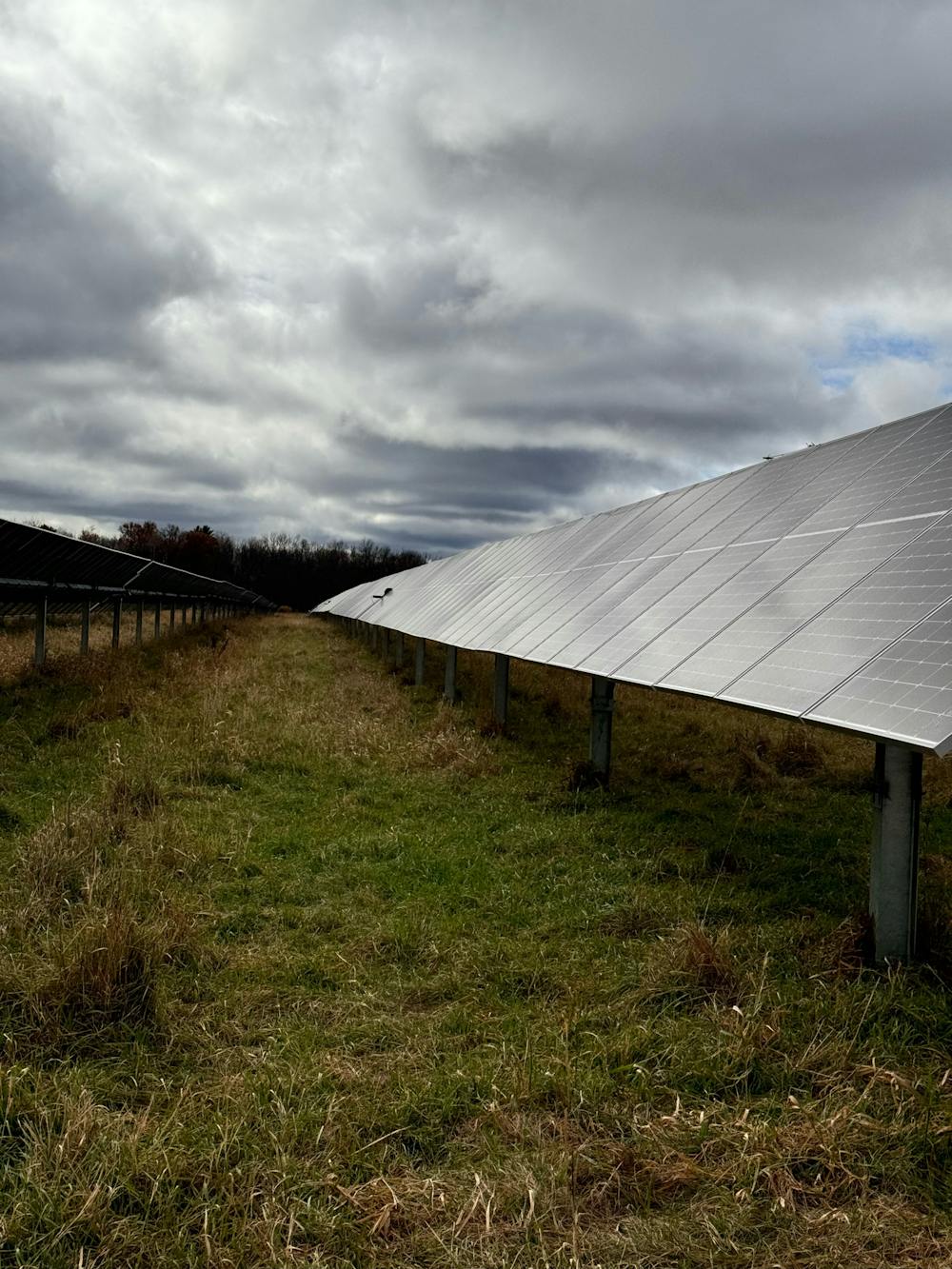Middlebury College President Laurie Patton cut the ribbon to officially open the South Street Extension solar array on Thursday, Oct. 24, unveiling a project that will now provide 40% of the college’s total electricity. The college hosted the event along with the developer, Encore Renewable Energy, and owner and operator, Greenbacker Renewable Energy Company.
Thursday marked the culmination of a three-year project which broke ground on Oct. 12, 2021. The array was built as part of Energy2028, Middlebury’s commitment to use 100% renewable energy and reduce the college’s energy consumption by 25% by 2028; to divest from fossil fuels by 2034; and to foster interdisciplinary educational engagement with the initiative.
The private ribbon-cutting event was attended by members of the college administration, Encore, Greenbacker and several local news outlets. Founder and co-CEO of Encore Chad Farrell opened the event by thanking the college for seeing through on a “solar coaster” of a project. He explained how this project aligned with the Burlington-based company’s principles.
“As a B Corp, we believe in the foundational principles of people, planet and profit, and this project is a perfect example of that,” Farrell said, adding that students played a central role that students played in advocating for sustainable practices.
“Were it not for the students of Middlebury College, this project would not be here. They really sort of championed the idea of having a locally cited, local generation of clean renewable energy to support the campus,” he said.
Both Patton and Executive Vice President of Finance and Administration David Provost echoed that students have been integral to establishing Energy2028 and to this solar array initiative.
“It’s also included — and I want to make sure you all know this — input from our students who contributed to the solar array through research, project-based learning, signage and collaboration to remain, as they always push us to, at the forefront of climate productivity, of climate education and of climate justice,” Patton said.
The array includes 15,348 solar panels which will generate about 10 million kilowatt-hours per year of energy for the Green Mountain Power electrical grid, where the college sources its energy, according to a college press release. Encore plans to install an eight-megawatt-hour battery alongside the array, which will store any excess energy produced.
The site of the array was chosen for several reasons, including its proximity to Green Mountain Power power lines and because this tract of college-owned land would never be used for core educational purposes, according to Provost. The college had originally planned to locate the array on a more concealed hill west of the current site but moved the project lower, largely for economic reasons, according to prior reporting by The Campus.
Neighbors were informed of the array’s location but were not consulted throughout the decision-making process, according to South Street Extension resident and Dean of the Library Mike Roy.
A larger issue, he believes, is that the town of Middlebury has no formal plan for siting large-scale solar projects. Having such a plan would, in theory, give the town preference in contesting a developer’s project before the Vermont Public Utility Commission (PUC), a state body that issues these permits.
“My sense is that these things might go more smoothly if these conversations happen earlier and involve… a kind of community process to sort out where [they] should go and then, for those who are impacted by it, what would the community benefits be of such installations,” Roy said.
The nearby town of Panton, Vt. is currently contesting a proposed 300-acre solar field because it does not comply with the town’s Enhanced Energy Plan. This is the first developer–town conflict before the PUC and will provide insight into how much weight town planning is afforded before the state commission.
He added that from his own perspective and from what he has read, when developers make firm commitments to providing community benefits alongside the development project, it is far more palatable to neighbors.
Such community benefits were proposed by the 2022–2023 Middlebury Environmental Council — an advisory group composed of students, faculty and staff — which envisioned promoting inclusive student and community engagement with the land by adding outdoor classroom spaces and building trails that connect to the Trail Around Middlebury (TAM), among other efforts.
“Those of us who live out here were kind of excited about getting, you know, an enhanced trail, so that we can more easily connect to the TAM,” Roy said.
The current Environmental Council has no projects focused on the solar site, according to Jack Byrne, dean of sustainability and environmental affairs and co-chair of the council.
Now that the solar array is active, regulations stipulate that additional land be conserved.
The land for the solar project was zoned through a Certificate of Public Good permit from the PUC, which requires that land double the size being used for development be set aside in a “management parcel.”
Associate Laboratory Professor of Environmental Studies and College Lands Conservationist Marc Lapin explained in an email to The Campus that in line with Vermont Fish and Wildlife Department guidelines, this parcel must provide habitat to grassland birds, meaning that the hay cannot be mowed for some time during nesting season to allow baby birds to fledge and safely leave their nests.
The proposed management parcel includes 95 acres of fields just north of the South Street solar array as well as 21 acres of the Jackson Lands in Cornwall.
At the Thursday ribbon-cutting, under an ironically cloud-covered sky, Patton closed her remarks by paying tribute to the history of deriving energy from the sun.
“As many of you know, I’m a student of ancient mythology, and the number one thing that brought people together, according to early theorists of mythology, was the honoring and worship of the sun,” Patton said. “It’s about as ancient as it gets, gathering around the sun and allowing the sun to power us in new ways. So I want to remind everyone that we are both super innovative and super ancient.”
Evan Weiss '25 (she/her) is a News Editor.
Evan is an IGS major and math minor from Philadelphia, PA. When she's not editing for The Campus, she's either working as a peer writing tutor, running on the TAM, or eating chocolate chips from Proc.




